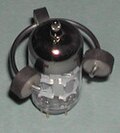Microphonics
Microphonics or microphony refers to the phenomenon where certain components in electronic devices transform mechanical vibrations into an undesired electrical signal (noise). This issue is most prevalent in vacuum tubes, capacitors, and cables, especially in high-gain audio amplifiers, radio transmitters, and sensitive measuring equipment. The term originates from the early days of radio and phonograph technology, where microphonic effects were first observed.
Causes and Effects[edit]
Microphonics is caused by mechanical vibrations that induce an electrical signal in a component. In vacuum tubes, for example, these vibrations can modulate the distance between the anode and cathode or between other elements within the tube, altering the flow of electrons and thus the current. This modulation translates into noise that can be amplified by the device, leading to feedback, hum, or other unwanted sounds. In capacitors, mechanical stress can change the capacitance, while in cables, it can modulate the resistance or induce piezoelectric effects.
The impact of microphonics varies depending on the application. In audio equipment, it can degrade sound quality by introducing noise and feedback. In radio transmitters, it can cause frequency modulation of the signal, leading to interference. In sensitive measuring instruments, it can introduce significant errors in the measurements.
Mitigation[edit]
To mitigate microphonics, manufacturers and users employ various strategies. These include:
- Using components that are less susceptible to microphonics, such as solid-state devices instead of vacuum tubes.
- Mechanical damping of components to reduce their vibration.
- Careful physical layout of the device to minimize the impact of vibrations.
- Using low-noise cables and connectors.
- Encasing sensitive components in epoxy or other damping materials.
Examples[edit]
One classic example of microphonics is the feedback heard when a microphone is too close to a speaker. In this case, the sound from the speaker causes the microphone diaphragm to vibrate, which is then amplified and sent back to the speaker, creating a feedback loop. In vacuum tube amplifiers, tapping on the chassis can produce a ringing or buzzing sound through the speakers, indicating microphonic tubes.
Conclusion[edit]
Microphonics presents a challenge in the design and use of electronic devices, particularly in audio and radio applications. Understanding the causes and implementing effective mitigation strategies is essential for minimizing its impact and ensuring the quality and reliability of electronic equipment.
Microphonics gallery[edit]
-
Ultra II
-
Valve Hammer
Ad. Transform your life with W8MD's Budget GLP-1 injections from $75


W8MD offers a medical weight loss program to lose weight in Philadelphia. Our physician-supervised medical weight loss provides:
- Weight loss injections in NYC (generic and brand names):
- Zepbound / Mounjaro, Wegovy / Ozempic, Saxenda
- Most insurances accepted or discounted self-pay rates. We will obtain insurance prior authorizations if needed.
- Generic GLP1 weight loss injections from $75 for the starting dose.
- Also offer prescription weight loss medications including Phentermine, Qsymia, Diethylpropion, Contrave etc.
NYC weight loss doctor appointmentsNYC weight loss doctor appointments
Start your NYC weight loss journey today at our NYC medical weight loss and Philadelphia medical weight loss clinics.
- Call 718-946-5500 to lose weight in NYC or for medical weight loss in Philadelphia 215-676-2334.
- Tags:NYC medical weight loss, Philadelphia lose weight Zepbound NYC, Budget GLP1 weight loss injections, Wegovy Philadelphia, Wegovy NYC, Philadelphia medical weight loss, Brookly weight loss and Wegovy NYC
|
WikiMD's Wellness Encyclopedia |
| Let Food Be Thy Medicine Medicine Thy Food - Hippocrates |
Medical Disclaimer: WikiMD is not a substitute for professional medical advice. The information on WikiMD is provided as an information resource only, may be incorrect, outdated or misleading, and is not to be used or relied on for any diagnostic or treatment purposes. Please consult your health care provider before making any healthcare decisions or for guidance about a specific medical condition. WikiMD expressly disclaims responsibility, and shall have no liability, for any damages, loss, injury, or liability whatsoever suffered as a result of your reliance on the information contained in this site. By visiting this site you agree to the foregoing terms and conditions, which may from time to time be changed or supplemented by WikiMD. If you do not agree to the foregoing terms and conditions, you should not enter or use this site. See full disclaimer.
Credits:Most images are courtesy of Wikimedia commons, and templates, categories Wikipedia, licensed under CC BY SA or similar.
Translate this page: - East Asian
中文,
日本,
한국어,
South Asian
हिन्दी,
தமிழ்,
తెలుగు,
Urdu,
ಕನ್ನಡ,
Southeast Asian
Indonesian,
Vietnamese,
Thai,
မြန်မာဘာသာ,
বাংলা
European
español,
Deutsch,
français,
Greek,
português do Brasil,
polski,
română,
русский,
Nederlands,
norsk,
svenska,
suomi,
Italian
Middle Eastern & African
عربى,
Turkish,
Persian,
Hebrew,
Afrikaans,
isiZulu,
Kiswahili,
Other
Bulgarian,
Hungarian,
Czech,
Swedish,
മലയാളം,
मराठी,
ਪੰਜਾਬੀ,
ગુજરાતી,
Portuguese,
Ukrainian


